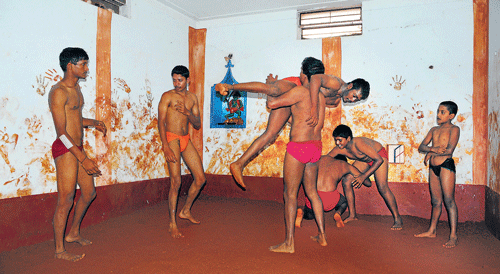It is a widely held belief that education is not a cup of tea for pehalwans. In a changed scenario, Mysore’s young wrestlers are out to wipe out the deep-grained belief. A round of garadimanes (wrestling houses) in different mohallas of the city is enough to confirm the turnaround.
Brand new cell phones in hand, sporting goggles, wearing skin-tight t-shirts and jeans, they walk in. Completing the story of the new-age wrestlers are the backpacks loaded with books. They are not fully smitten by the bug of modern times, with their roots in naada kusthi (traditional mud wrestling) not at all forgotten.
Mysore's very own naada kusthi is still a must for the new generation of wrestlers, for whom their forefathers remain an inspiration even as they pursue higher studies. Examples abound in students like Bhaskar, a BBM student from Ittigegoodu garadi, Basavesh, a BA student, Thaygaraj from Bogadi garadi who is pursuing his B.Com degree and BBM graduate Chetan, who is also from Bogadi garadi.
“My father (Pehelwan B K Ganesh) never allowed me to go to garadi mane. He always insisted that my younger brother and I should pursue studies,” says Chethan. “But we were drawn to kusthi and we started training. But we never neglected our studies. I have won 40 bouts of naada kusthi around Mysore. It has helped me to keep fit and stay healthy. I want to learn freestyle wrestling also,” he adds.
What has compelled the new generation to try and balance wrestling and education is that unlike other sports, wrestling is not very rewarding in terms of fetching them jobs. For them, wrestling is still a revered tradition, a gift inherited from their forefathers who for them are living legends.
“We don’t want to forego what our ancestors left us with, we have been passing it on to the next generation,” says Yajaman S Mahadevappa, secretary of the Jayachamaraj Garadi Sangha. “My elder son Praveen is a B Com graduate and national-level medal winner in wrestling and another son is an MBA besides being a national-level wrestler. The two are well-settled. I am also training my grandson (daughter’s son), who is studying in an English medium school,” adds Mahadevappa with a touch of pride.
In the days gone by, royal patronage kept the art of wrestling going. It may have lost some of its sheen compared to its heydays during the reign of the Wadiyars but even now, Mysore has 50 documented garadi houses where men slug it out on the mud to get their moves right. The love for the sport keep them going.
“Every day, I wake up at five to go for physical training while the afternoons are dedicated for learning kusthi,” says Deepak Kiran of Chikka garadi in Ashokpuram. Kiran is pursuing his BA degree at an evening college.
“I am not facing any problems in balancing studies and wrestling. Thanks to wrestling, I have been able to stay clear of bad habits.”
Rising cost of living is a factor that has had an impact on wrestling, a sport that requires a solid diet, including milk, eggs, dry fruits and meat. The growth of martial arts like karate has also had an impact while many turn to multi-gyms to tone their bodies these days.
Despite the hurdles youngsters are still drawn towards wrestling. Sadly though, there is little support from the government and the demand for a hostel to house aspiring wrestlers has been long-pending. Budding wrestlers feel that if better facilities, including accomodation are provided, many more will venture out to learn a sport that is bringing laurels for the country.
Except at the University of Mysore, there is no facility to learn mat wrestling. “It is good that students are developing interest in the traditional sport. It is also interesting to note that women’s wrestling is picking up. They are doing well in national-level bouts now,” says L Manjappa, Mysore University wrestling coach.
With the new generation sustaining the interest in the sport, wrestling in Mysore may flourish in the future as well. All it needs is some support to keep the fire burning.
